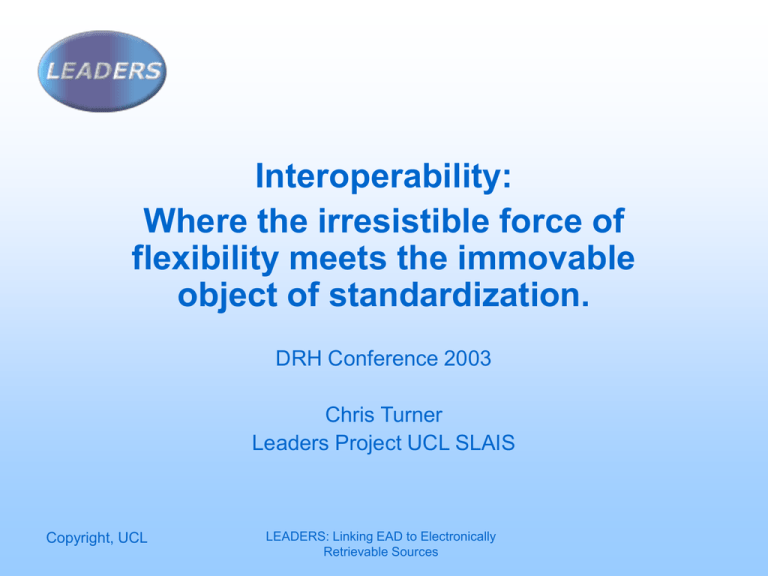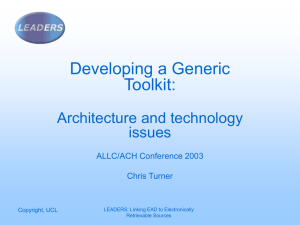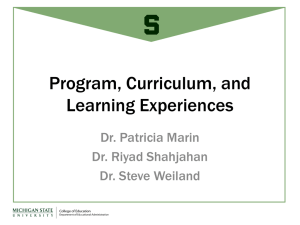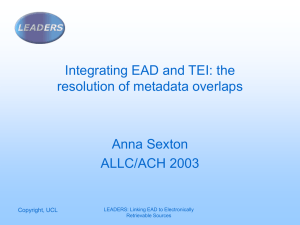Interoperability: Where the irresistible force of flexibility meets the immovable object of standardization.
advertisement

Interoperability: Where the irresistible force of flexibility meets the immovable object of standardization. DRH Conference 2003 Chris Turner Leaders Project UCL SLAIS Copyright, UCL LEADERS: Linking EAD to Electronically Retrievable Sources Conflicting needs • Flexibility in encoding – Wide range of source materials – Existing practices • Standardisation – Reusability – Support – Sustainability Copyright, UCL LEADERS: Linking EAD to Electronically Retrievable Sources Interoperability ‘to be interoperable, one should actively be engaged in the ongoing process of ensuring that the systems, procedures and culture of an organisation are managed in such a way as to maximise opportunities for exchange and re-use of information, whether internally or externally’ Miller, Paul. ‘Interoperability. What is it and Why should I want it?’, Aridane, Issue 24 (21 June 2000) http://www.ariadne.ac.uk/issue24/interoperability/intro.html Copyright, UCL LEADERS: Linking EAD to Electronically Retrievable Sources 6 Aspects of Interoperability • • • • • • Technical Semantic Political/Human Inter-community Legal Informational Copyright, UCL LEADERS: Linking EAD to Electronically Retrievable Sources Technical Interoperability • the ‘plumbing’, or what goes on out of sight to make documents accessible. – http – tcp/ip – etc Copyright, UCL LEADERS: Linking EAD to Electronically Retrievable Sources Semantic Interoperability • Works on different levels and enables us to understand and transform documents – Syntactic level • XML rules for well-formedness provide a standardized structure for files – Semantic level • Common convention for naming parts of a document – DTD/Schema – Structural level • Determines how parts of a file relate to each other – the content models described by a DTD/Schema – Content level • What does the document actually say. E.g. Index terms for searching, and lists of descriptors Copyright, UCL LEADERS: Linking EAD to Electronically Retrievable Sources Interoperability of TEI and EAD documents • they can be moved between computers and accessed between computers • being XML they have a recognized syntactic structure • they use common tag libraries, and thus have consistency of naming. • the content models of the DTDs offer commonly defined structures • the DTDs offer some pre-defined attribute values. Copyright, UCL LEADERS: Linking EAD to Electronically Retrievable Sources Flexibility of TEI/EAD • A goal of EAD is to make archival resources from many institutions accessible to users. To achieve this goal, EAD must accommodate a wide range of internationally divergent descriptive practices (EAD Working Group, 2002). • It is important to remember...[that] many -perhaps most -- serious TEI applications have found it necessary to build their own customization of the full scheme in some way (Burnard, 2000). Copyright, UCL LEADERS: Linking EAD to Electronically Retrievable Sources Consequence No two documents created in EAD or TEI need have the same structural or content markup. – Limits possibilities for data exchange and reusability – Makes consistent search and retrieval and presentation of results difficult Copyright, UCL LEADERS: Linking EAD to Electronically Retrievable Sources Solution approach • Determined by project aims – ‘Document-centric’ – focus is on retrieval and presentation of TEI encoded transcripts and images • EAD used for metadata to facilitate search and retrieval • EAC used for contextual information – Reusability of files – Hospitality to existing files? Copyright, UCL LEADERS: Linking EAD to Electronically Retrievable Sources Contextual presentation Copyright, UCL LEADERS: Linking EAD to Electronically Retrievable Sources Metadata in EAD file item description in Leaders-EAD to harvest index terms and description from EAD documents resulting index document Copyright, UCL LEADERS: Linking EAD to Electronically Retrievable Sources Controlled terms for searching Copyright, UCL LEADERS: Linking EAD to Electronically Retrievable Sources TEI - descriptive markup • Pizza Chef approach helpful • Wide range of formats of archival documents • Descriptive/procedural distinction • But just one DTD. • Modify stylesheets Copyright, UCL LEADERS: Linking EAD to Electronically Retrievable Sources Examples Example EAC document Example TEI document Application example Copyright, UCL LEADERS: Linking EAD to Electronically Retrievable Sources TEI DTD modification TEI for Archives DTD Abbreviations entity file Copyright, UCL LEADERS: Linking EAD to Electronically Retrievable Sources Re-use through Web Services • Standardisation of encoding makes possible standardised application functions. • Application functions described by WSDL (Web Services Description Language) file • Means application developers can incorporate LEADERS functions into their own applications. Copyright, UCL LEADERS: Linking EAD to Electronically Retrievable Sources Conclusions • Trade-offs – EAD: stricter control vs loss of hospitality to legacy data and variation in existing practices. – TEI: a single DTD but hospitality to a potentially wide range of source materials vs less reusability of stylesheets. • Paradox – More standardisation of encoding vs more flexibility in terms of interoperability. Copyright, UCL LEADERS: Linking EAD to Electronically Retrievable Sources




